SEX INDUSTRY IN JAPAN
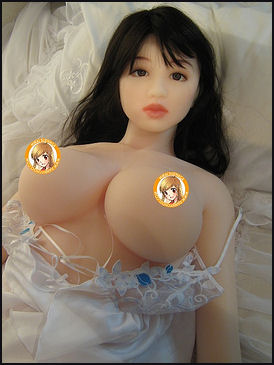
sex shop doll There are more than 12,000 sex-related businesses in Japan, and, according to research by Takashi Kadokura of the Dai-ich Life Research Institute, they earn $15 billion a year. Not only is the sex business impressive in its size, it is also impressive in its variety. In Japan you can find brothels that fall under the names of Soaplands, Image Rooms, Fashion Health, Pink Salons, Delivery Health, Cabaret Clubs, Turkish Baths and massage parlors with names like Love Station Lounge. There are also S-and-M clubs, S-and-M museums, she-male revues, and street corner prostitutes dressed in bunny suits.
The competition is stiff to give customers what they want and attract regular, repeat customers. Some "pink" establishments are open 24 hours. Some offer alibis to wives, mothers and girlfriends. Others take reservations, address specific requests and have websites that list which girls are on duty and when. Most of the businesses are geared towards Japanese customers only. Foreigners are generally not welcome due to fears about AIDS and other concerns.
Japan has had anti-prostitution laws on the books since 1958. Even so most of the sex business operate legally by calling themselves restaurants or baths. Those that operate illegally are left alone by police, who feel they provide a service for men who otherwise might cause trouble. Few workers or customers are arrested. In 2000, only 588 women were charged with prostitution.
Sex Industry in Japan Pink Box, Inside Japan’s Sex Industry pinkboxjapan.com ; You Tube Video of Tokyo Sex Club Tour YouTube ; Wikipedia article on Prostitution in Japan Wikipedia ; Brothels in Osaka on 21 or Over,com 21orover.com ; Japan Times article on Osaka Brothels Japan Times Sex Trafficking Video International Labor Organization ; Kabukicho Kabuki-cho (part of Shinjuku) is regarded as Tokyo's largest entertainment district and is the center of Tokyo’s sex industry. Websites: Wikipedia article Wikipedia ; Guardian article Guardian ; Books: “ Pink Box, Inside Japan’s Sex Industry “; “Tabloid Tokyo” volumes 1 and 2 (Kodansha International), tales of sex, crime and the bizarre.
Links in this Website: SEX IN JAPAN Factsanddetails.com/Japan ; PROSTITUTES, SEX CLUBS AND SEX INDUSTRY IN JAPAN Factsanddetails.com/Japan ; HOSTESSES, HOSTS AND STRIPTEASE IN JAPAN Factsanddetails.com/Japan ; SEX, CHILDREN, TEACHERS AND SUBWAYS IN JAPAN Factsanddetails.com/Japan ; SEX, DATING CLUBS AND SCHOOLGIRLS IN JAPAN Factsanddetails.com/Japan ; HOMOSEXUALITY IN JAPAN Factsanddetails.com/Japan
Prostitutes in Japan
Prostitutes are known as "women who sell spring." They work in sex clubs mentioned below. In cities like Kawasaki you can find red light districts with foreign Asian women displayed in Amsterdam-style windows. One Japanese psychiatrist told the Japan Times, "Patronizing a 'pink business' is a very convenient way for the more affluent Japanese to engage in pleasure. Males tend to go to such places first just for fun; second for momentary satisfaction without bother or responsibility; and third, for confirmation of their masculinity." One frequent and satisfied customer told the magazine Spa!, "Prices haven't gone up for the past 20 years or so. Yet the quality of the girls keeps getting better, and the services they dispense get bolder all the time."
According to a 1981 survey, younger prostitutes remained in the trade for three to four years; another small survey of sex workers in the Senzoku-Yoshiwara area in 1988 showed the average age was 26 and careers lasting about sixteen months. In the 1986 survey conducted by the Prime Minister’s Office, nearly 10 percent were housewives, another 10 percent office employees, and 4 percent students. More than half cited “making a living” as the motivation, 14 percent were doing it “for the sake of the family,” 11 percent were doing it to pay off debts, while others cited money for clothes, travel, and leisure (Bornoff 1991, 273, 334). [Source: Yoshiro Hatano, Ph.D. and Tsuguo Shimazaki Encyclopedia of Sexuality, 1997 ++]
History of Prostitution in Japan
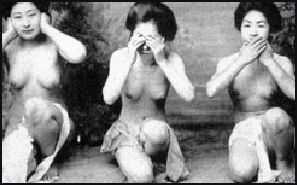
old nudy pictures In the Edo Period (1603-1867), fashion trends were often set by prostitutes and courtesans. Daruma, the name of a Zen master who mediated until his legs fell off, was a slang expression for a courtesan. Ukiyo-e prints from the 18th century show prostitutes interacting with Buddhist figures.In the 19th century prostitutes often dressed like geishas, and were displayed behind bars like animals. Love it was said was more common with prostitutes than with wives.
In the old days many prostitutes were sold into the profession by their parents. Many went through an initiation rite and worked as virtual slaves until the debts were paid back. Lucky ones found a client who fancied them and put up the money to win their early release. If a prostitute was sick and lost her customers she could be thrown out on the streets. If she died her body was disposed of in the cheapest way possible. Many were so miserable that samurai were forbidden from bringing their swords into brothels out of fear that the prostitutes would use them to kill themselves.
Yoshiro Hatano, Ph.D. and Tsuguo Shimazaki wrote in the Encyclopedia of Sexuality: [Prior to 1948 and the enactment of the Law for the Regulation of Businesses Affecting Public Morals, prostitution was not a criminal offense. The 1956 Prostitution Prevention Law granted the country’s red-light districts a year’s grace, after which the estimated 260,000 sex workers in the 50,000 hitherto licensed brothels would have to find other means of earning a living. The 1956 law also banned sexual slavery and the practice of selling daughters into the brothel trade. New revisions of the public morals were added in 1984. [Source: Yoshiro Hatano, Ph.D. and Tsuguo Shimazaki Encyclopedia of Sexuality, 1997 ++]
Both before and after the new law, however, the operation of sex-orientated businesses was, and is subject to obtaining “prior permission” from the police and local authorities. This at once casts doubt upon how illegal such things actually are and just what kind of arrangements operators are expected to make in order to open shop. The fact is that bars, cabarets and other concerns employing hostesses are free to operate, provided their services abide by officialdom’s favorite old (and sometimes highly coercive) chestnut of “voluntary restraint.” “Most of the sex industry is illegal, yet it goes on just the same,” the editor of a Tokyo magazine focusing on the mizu shobai recently affirmed. “As in the strip theaters, people usually know when the police are coming to raid them. In businesses like these, there’s a lot of money changing hands under the table.” (Bornoff 1991, 332) ++
According to the 1984 More Report of Male Sexuality, the majority of men over 30 had their first sexual intercourse experience with a prostitute, whereas those in their 20s tended to have their first encounters with a girlfriend. ++
Japanese Women Who Work as Prostitutes
The weekly magazine Spa! estimates that there about 225,00 women working in the sex trade. These included 48,000 women who work at Japan's 1,000 "fashion health" and "image clubs;" 25,300 who work at the 1,265 the soaplands, 16,000 who work at the 1,000 "delivery health," 28,430 who work at pink salons, 75,000 who work in cabaret clubs and 20,000 who work at S-and-M clubs.
According to one estimate about seven percent of all the women between 20 and 24 work in the pink business. The turn over rate is high. One average a sex industry business employs five times the number of people in a year that is found working there on a single day.
Japan does not have a large underclass of drug addicts, so many prostitutes and sex trade workers are housewives or women or girls from otherwise respectable families. Many of the these women are recently divorced or unemployed, or are working to pay off mortgages or credit card debts and are very uncomfortable about way they have been forced to do.
Women looking for such jobs answer ads in magazines, such as Witty Pat, that specializing in finding sex trade workers, promising "part time jobs with high income" or are recruited on the streets young pimp-like "scouts” who are paid $500 or more for every woman they recruit. When the alternative is being paid $8 an hour to work in a fast food joint or a convenient stores many women find the offers of $300 a day or $6,000 a month to be too good to resist.
The ads are often explicit. They say things like "no rough play" and "You can use a condom, while giving oral sex." They also promise flexible hours, transportation fees, employee housing, alabi services, and dare care for young children.
Chinese Prostitutes in Japan
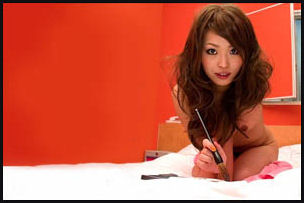
sex worker in Japan In Kabukicho in Tokyo many of the prostitutes and sex workers are Chinese. Many of them work for Chinese gangs rather the yakuza. They enter the country on student visas or obtain spouse visas after they "marry" Japanese men. They are in demand because they work for less than their Japanese counterparts.
Many of the Chinese women are educated and ambitious to get ahead. The work at hostess bars and love hotels from 9:00pm to 5:00pm, making considerably more money than they could back home, and spend their free time studying and taking English and Japanese lessons. With some, once they save enough money they go home and start businesses.
One 25-year-old prostitute told the New York Times, "None of us like Japanese men. They're so different from Chinese people. They are cold, and we're warm. They like distance, and we like to e close. I wouldn't choose them for pleasure.”
Sex Slaves in Japan
Some of the foreign women who work as prostitutes are regarded as sex slaves. Some were lured from their home countries by sex brokers with promises of well-paid legitimate jobs in Japan but then forced to work as prostitutes in Japan to pay off the “arrangement fee” spent to bring them to Japan. They live in squalid housing and sometimes eat nothing but cup of noodles. Those that try to escape are fined and beaten. Threats were made against their families back home.
The women come from all over. A woman from Hungary working at a bar that advertised “White European Women” in told the Times, “Back in Hungary there were people who told use about jobs where we just had to pour drinks for Japanese businessmen, laugh at their jokes and earn $10,000. When I arrived in Tokyo... I was met by an agent, who raped me and took my passport and all my documents. I can’t go anywhere. I live in a tiny place and all the money I make has to go straight back to the agent.”
The International Labor Organization has criticized Japan for treating victims like criminals and not doing enough to stop sex slavery. On the Japanese gangsters who control her, the woman fro, Hungary said, “When they say they would hurt my family I believe them. The Japanese police known everything about it, but did nothing.”
Thai Sex Slaves in Japan
Some of the Thai women who work as prostitutes in Japan are little more than sex slaves. Many have been lured from Thailand by sex brokers with promises of well-paid legitimate jobs in Japan but then are forced to work as prostitutes in Japan to pay off the multi-thousand-dollar “arrangement fee” spent to bring them to Japan. These days there are less Thai women working in Japan than in the past as they largely been replaced by Chinese women.
By one count there are 22,500 Thai women in Japan in the early 2000s. Of these women 80 or 90 percent were employed in the sex trade and of these many were sex slaves. Those that ended up as sex slaves were brought into Japan with the help of a broker, who got the women false passports and documents. Once safely into Japan, they were sold for $25,000 to $40,000 to their new “owners,” who were sometimes connected with the yakuza (the Japanese mafia). Many work at low-end brothels or “dating” snack bars or love hotels.
Japanese men paid $220 for a couple hours or $300 for the night. Most women worked between 7:00pm and 2:00am and had two to four clients in that time. They often worked everyday, even when they had their period. The women rarely saw the money, which was pocketed by their boss or “mama” as payment for their debts. They were supposed to turn over their tips but some managed to kept them by placing them in a plastic bag that they hide in their vagina.
The Thai sex slaves in Japan often lived in squalid housing and often had little to eat but cup of noodles. Their “owners” kept their passports. If they tried to escape they were fined and beaten. Threats were made against their families back home. If they sought help from Japanese authorities they risked being deported. In many cases they lived in dormitories above the establishments where they work. These places were outfit with video cameras, motion censors and buzzing doors to keep track of the women.
In 2005, a Japanese salaryman and a Thai woman were arrested for selling a 13-year Thai girl into prostitution in Japan for about $20,000. The girl was arrested and deported. She said she had come to Japan with a promise of a good job and ended up $40,000 in debt to the people that brought her from Thailand. She said she had sex with more than 200 men in several places in the Tokyo area and was paid only $250 plus minimal living expenses. In December 2008, 12 Thai women were rescued from forced prostitution in Utsunomiya, Japan. The 12 women were in their 20s and 30s. Each was brought to Japan and owed their captors around $50,000.
Report: : “ Owed Justice: Thai Women Trafficked Into Debt Bondage in Japan” by Human Rights Watch
Pink Salons and Delivery Health
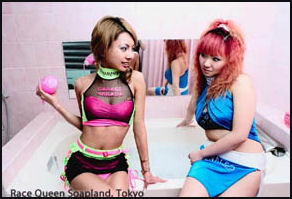
soaplands workers
“Pink Salons” (“Pinsaro”) are clubs where negligee-clad hostesses perform oral sex on customers in dimly-lit cubicles. Fashion Health are massage parlors that feature nude bathing and sexual services short of sexual intercourse. The word "health” implies that sexual diseases can be avoided by patronizing them. “Hotetoru” are unlicensed soapland-like services offered in a hotel. “Mantoru” is similar to a hotetoru except the services are offered in an apartment or condominium. [Source: Mark Schreiber, Japan Times, July 8, 2001]
"Aesthetic Salons" (“Esute”) offer bare quickie minimum services for low prices and charge extra on an à la carte basis. The cheapest item is a manual "prostate massage." Sexual intercourse costs considerably more. Aesthetic Salons are a relatively new service. They employ foreigners, mostly Chinese and Filipinas, and are regarded as the fast food chains of the sex industry. Many have signs that read “Kankoku” ("Korean") esute, Chinese esute or Taiwan esute.
"Delivery Health" (“Deri-su”) services send women to addresses specified by a customer. This can be a home, a love hotel or even a expressway rest area. Almost everyday mail boxes are stuffed with small advertisements for call delivery services. The ads picture naked women or uniformed schoolgirls in suggestive positions and list a menu with 30 minutes with one play for $100, 60 minutes with two play for $150, 90 minutes with three play for $200 and 120 minutes with four play for $250. Similar ads are found in telephone booths and the backs of tissues given out on the street by young girls and in the backs pages of sports tabloids. Internet and cell phones users are also spammed with similar services.
Soaplands
“Soaplands” are places with small private rooms where men go for massages or sexual services provided by scantily-clad women. Soaplands tend to be expensive. The one in the Yoshiwara district of Tokyo offers one or two hour sessions for between ¥25,000 and ¥100,000. In Nagoya these places are often called saunas. Soaplands used to be called Turkish Baths until the Turkish Embassy lodged a complaint. [Source: Mark Schreiber, Japan Times, July 8, 2001]
Yoshiro Hatano, Ph.D. and Tsuguo Shimazaki wrote in the Encyclopedia of Sexuality: It is still quietly accepted and understood that a Japanese husband may join business associates or friends for a visit to a “Soapland” red-light district. The “Soapland” districts in Japanese cities are not an ordinary European or American red-light district. Like the fantasy land of the “love hotels” which provide much-needed romantic privacy for young couples living with parents or with their children in tiny living quarters with no privacy, a “Soapland,” like Kobe’s venerable Fukuhara district, leaves nothing to be desired in terms of local color, and works up a merry throng on Saturday nights (the streets are nearly deserted on weekday nights). [Source: Yoshiro Hatano, Ph.D. and Tsuguo Shimazaki Encyclopedia of Sexuality, 1997 ++]
In Fukuhara’s unimaginably gaudy streets, the predominant bordello architecture would put even the most fanciful love hotels to shame. The usual shoguns’ castles are dwarfed by edifices with stucco baroque facades arrayed with colorful son et lumière, and the odd rickety little old Japanese brothel is eclipsed by adjacent chrome-and-smoked glass pleasure domes and sci-fantasy ferroconcrete extravaganzas from some Babylonian lunatic fringe. Here and there touts in proper yakuza uniform lunge in front of the doorways, all short-cropped frizzy hair and neon lights winking kaleidoscopically in their dark glasses. Otherwise pandering seems undertaken entirely by the descendants of the old yarite, aging women sitting on chairs and hailing passers-by. ++
Fukuhara’s Soapland foyer interiors have to be seen to be believed. Sprayed fluorescent pink, statuary modeled after Botticelli’s Venus rising from the waves stand blushing outlandishly beneath a red roof evoking a Shinto shrine; traditional Japanese cranes in chromium wing their way across a back lit diorama of the Chateau de Chenonceaux....In the interests of mandatory discretion, the showy facades completely conceal the executrixes within. Upon crossing the threshold, it becomes apparent that Soapland ladies join the employees of cabarets and pink salons in a great variety of fancy dress: old-time courtesans in florid kimono, nurses, airline flight attendants, bunny girls, Suzy Wongs in high-necked mini cheongsams slit up the sides, SM leather goddesses and Buddhist and Catholic nuns (Bornoff 1991, 271, 263-264). ++
Sex at a Soaplands
Yoshiro Hatano, Ph.D. and Tsuguo Shimazaki wrote in the Encyclopedia of Sexuality: The leisurely ritual of a Soapland visit starts with a ceremonial undressing, followed by a relaxing sudsy sponge bath and gentle massage, a rinse, and a lather dance (awa-odori) or body-body massage in which the Toruko-jo (female) or Sopu-reedi (Soap-Lady) massages every part of her client’s body with every part of her body on a king size inflated rubber mattress. Another rinse and a skillful shakuhachi, in which the Soap-Lady displays her charms, lead into an artistic performance of sexual arousal that culminates in intercourse. All this occurs with a curious single-minded determination and absolutely no pretense of emotional involvement. [Source: Yoshiro Hatano, Ph.D. and Tsuguo Shimazaki Encyclopedia of Sexuality, 1997 ++]
The old-style, leisurely coital sex play with geishas and Soap Ladies, however, is declining in favor of quick, cheaper (and hence more frequently affordable) masturbation, oral sex, and voyeurism. The equivalents of “fast food,” non-coital sexual release for males, now account for nearly half of the commercial sex trade. Herusu massagi and fashon massagi, health and fashion massage, are increasing in popularity. Independent women work in the video game halls, discos, date coffee shops (deeto kissa), mobile van services (Pinkku Shiataru), lovers’ banks (telephone date clubs), nude photo studios (popular in the 1970s and in decline since), or wait for calls responding to the pink leaflets (pinkku bira) they post in appropriate public places or drop in private mail boxes (see Section 8D in the chapter on the United Kingdom for a British parallel to pinkku bira). One factor in this shift is the high-pressure life and lack of leisure in the male business world; most white-collar workers (salary men) do not have a lot of leisure time or spare money to spend on the traditional commercial sex. Another factor, of course, is a recent growing awareness and concern about AIDS (Bornoff 1991,282-300). ++
Image Rooms and S-and-M Clubs in Japan
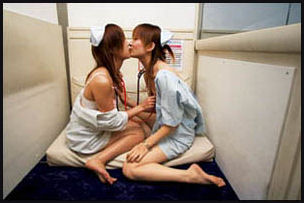
image room Image rooms are brothels where men indulge themselves in various fantasy situations, such as groping a woman in a crowded subway and getting oral sex inside a fancy car, with a prostitute. There is even an image room with facsimile toilet, which men can slide under and have a prostitutes urinate on their face.
Image rooms came into existence in the late 1980s. Sexual intercourse is generally not allowed. As part of the "costume play" women employees will dress up like school girls (complete with loose socks), nurses, waitresses, belly dancers, cheerleaders, science fiction characters, and even policewomen. As part of the "baby play" the customers are dressed up in diapers and entertained with lullabies, rattles and teething rings by the employee. Breast feeding costs extra.
S-and-M clubs are also relatively common. Customers can enjoy both masochism and sadism with devises such as ropes, handcuffs, leather whips, vibrators, "penis bands," tubes, and thigh-high stiletto-heeled leather boots. The mostly male clientele include salarymen, bureaucrats and company presidents. A place in Yokohama called "It's Bully" specializes in catering to customers who want be verbally abused. In regular S-and-M clubs, “joosamas” ("queens"), Japanese slang for a dominatrixs, charge up to $200 an hour to provide their services.
Confessions of a Japanese S-and-M Dominatrix
A “joosama” who calls her Karen told the Japan Times her interest in sadomasochism grew out of her teenage fascination with "bondage fashion." She tried playing M roles but didn’t like it much and switched to S roles. She then started working at an S-and-M club, where she was taught her craft by the resident mistress."
Karen told the Japan Times, "The whip, the leather boots, the loud voice" are only half the truth." Among the "pretty sick things” she does are drawing blood, sticking needles into human flesh and sticking a tube down men's urinary tracts. She said she enjoys her work and is not interested in conventional sex but considers herself a country girl who was brought in a normal family and enjoyed a happy childhood.
"Right from the start," Karen said, "I never thought it was a drag or anything. Of course there are some clients I simply can not stand the sight of. I get them to wear a mask and wrap their bodies in cling film....It is both weird and fun to see the pleasure I can give them....It makes me immensely happy” when they “play along with me. I am their 'queen.'"
Other Kinds of Sex Clubs in Japan
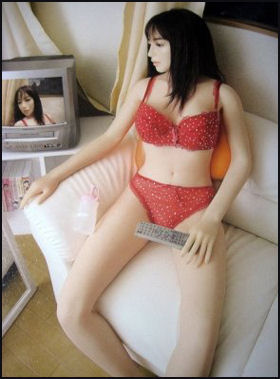
sex doll “Seikan esute” is a massage parlor that offers sex services starting at around $100. Because of their relatively low prices they have thrived in recession years. Cabaret Clubs allow customers and hostess to enjoy each others company in semi-private, dimly cubicles. Touts for such clubs in Kabuki-cho in Tokyo shout to potential customers "touch ten tits."
"No-pan shabu restaurants," are places where waitresses serve guests in short skirts with no panties and for a $100 tip will bend over for the customers. Some have mirrored floors.
“Kaitzenzushi kuabakura” are a combination sex club and fast-food sushi restaurant in which customers pay ¥8,000 for 50 minutes to fondle the breasts of a young woman called a “Yamame desu” ("trout lady") dressed like a sushi chef who allows her breasts to slip out of her “happi” vest.
The film “Shocking Asia”, showed a female fortunetellers who predicted the future by examining her customer's anus. The clients entered a van, paid a fee, pulled down their pants and a woman examined their ass holes and told them their fortunes.
There are even sex services that cater to aging men and handicapped people. The later are often identified by a green heart and a sign that reads "shop that gives priority to the handicapped."
Pornography in Japan
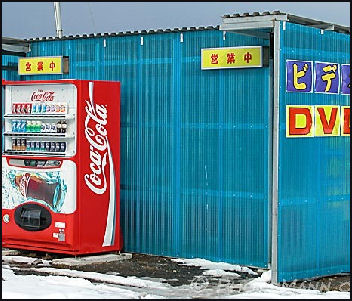
hidden porn vending machines Pornography is a multi-billion business in Japan. Tsutaya, Japan’s largest video rental chain, offers over 1,000 new pornography titles every month. Cell phone uses get unsolicited pornography of teenage girls sent by their mobile phone companies.
Approximately 14,000 adults-only videos are made in Japan every year (compared to 2,500 in the United States). Most regular video shops have "adults-only" corners, pornography sections with explicit material behind a sliding door. There are also numerous vending machines that sell pornography and nudie telephone cards.
A city worker in Wakayama Prefecture was punished — demoted and suspended from work for three months — for accessing adult websites up 170,000 times a month whole he was working. Overall he logged 780,000 hits of porn sites over a month period.
One of Japan's most famous porn stars is Choco Bon-Bon, a heroin addict and speed freak who appeared in the classic “Tales of a Hard Banana”.
Genitalia are often censored from nudie magazines and sex movies shown on television. One television a fussy, out-of-focus areascover genitalia. Pubic hair was once strictly forbidden but now it is tolerated in some circumstances."Hair nude" photo spreads are fixtures of a glossy men’s magazines
See Child Pornography
Elder Porn in Japan
“Elder porn” — pornography staring old people and marketed to old people — is one of the fast growing porn markets in Japan. About 300 of the 1000 new adult videos offered by Tsutaya, Japan’s largest video rental chain, feature “mature women.” In 1990s “mature women” referred to women in their late 20s. Now it includes women on their 70s.
One adult video producer told Time magazine that videos with young actresses sell well only the first three months after release while those with mature women sell well over a longer period of time, plus they are cheaper to make, with actresses only being paid $2,000 per film, compared to $100,000 for hot young actresses.
Shigeo Tokuda, who turned 74 in 2008 and survived a heart attack, had appeared in 350 adult films between 1993 and 2008. In many of the videos he portrays a polite gentleman who instructs women of different ages about various kinds of erotica acts. Among his biggest hits are “Maniac Training of Lolitas”, “Ah, My Lovely Bedfellow”, and “Forbidden Elderly Care”.
The producer of Tokuda’s videos told Time, “the adult video industry is very competitive. There were already adult videos with Lolitas or themes of incest, so we wanted to make something new.” A director of several elder porn films said that some his films had found a receptive audience among younger viewers. “It is because they lived much more,” he said. “We should respect them and learn from them.”
Some attribute the popularity of adult porn to simple demographics: that Japan as a whole is aging. Tokuda told Time, “Elderly people don’t identify with school dramas. It’s easier for them to relate to older-men-and-daughter-in-law series, so they tend to watch adult video with older people in them.”
Tokuda told Time he plans t keep working until he is 80. “People my age generally have shame, so they are very hesitant to show their private parts. But I am proud of myself for doing something they cannot.”
Japanese Sex Shops
One sex shop owner interviewed in the film “Shocking Asia” said that 70 percent of his customers were women. Item sold in the shop included hard core schoolgirl pornography, marital aids, dildos that move in strange directions at different speeds, and special anal dildos that looked like a string of Christmas ornament fastened together. Sex shops in the Kabuki-cho red light district in Tokyo have names like Pinky House and Super Exciting Pub UCLA.
Love Piece Club is a sex good store owned and operated by women. The items on sale, which are generally for and by women, are tastefully arranged in glass cases and include lotions, creams, DVDS and vibrators that look more like computer mouses than dildos. One of the designers said she found penis-shaped vibrator to be "just grotesque."
A “Burusera” are shops geared for fetishists. They often specialize in the sale of used women’s underwear and schoolgirl uniforms.
Image Sources: 1) and 7) Doug Mann Photomann vending machines in Japan site 2) Japan Visitors 3) 4) 5) 6) Joan Sinclair's book Pink Boxes 8) Hector Garcia
Text Sources: New York Times, Washington Post, Los Angeles Times, Daily Yomiuri, Times of London, Japan National Tourist Organization (JNTO), National Geographic, The New Yorker, Time, Newsweek, Reuters, AP, Lonely Planet Guides, Compton’s Encyclopedia and various books and other publications.
Last updated January 2013
